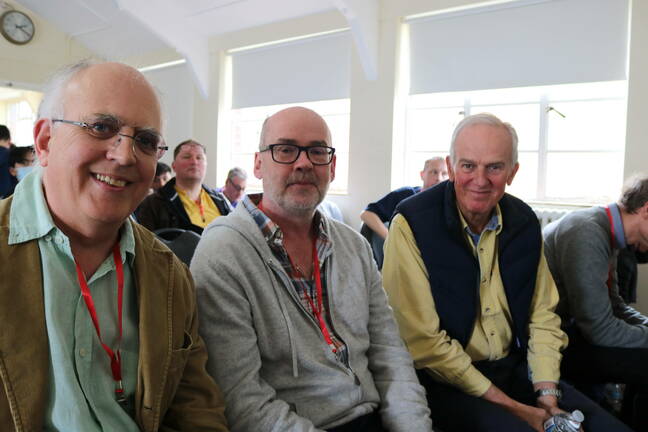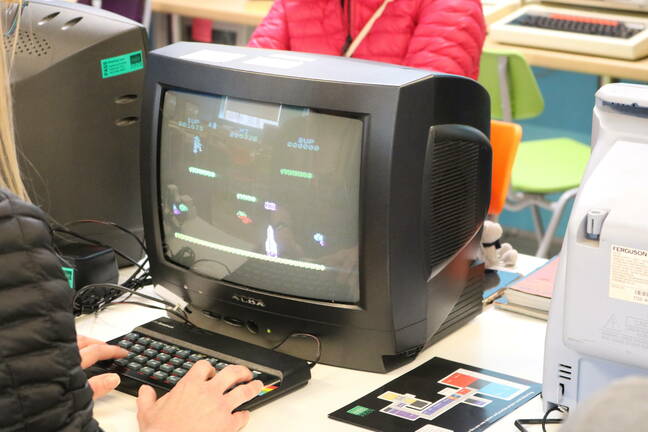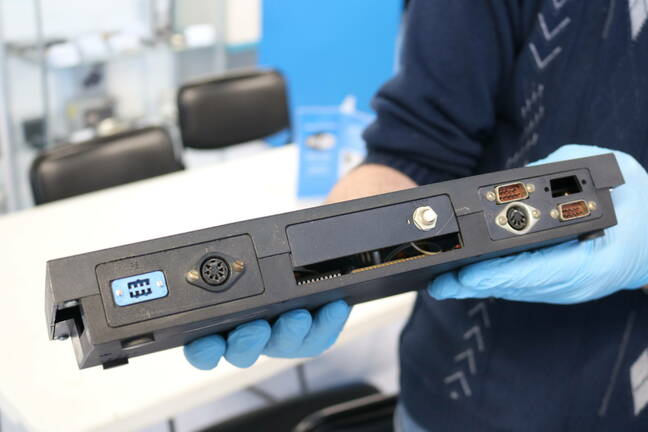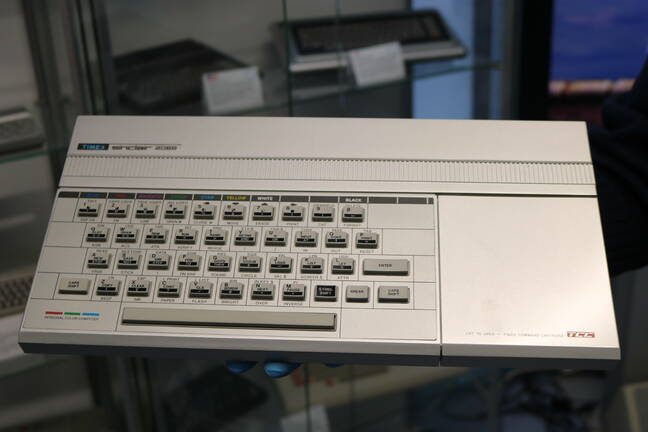ZX Spectrum: Q&A With Some Of The Folks Who Worked On Legendary PC
Interview The Register took a road trip last weekend to celebrate the ZX Spectrum's 40th birthday, and visited The National Museum of Computing in Bletchley Park and the Centre for Computing History in Cambridge in search of the origins (and clones) of the rubber-keyed marvel.
Present at The National Museum of Computing (TNMOC) were hardware designer Richard Altwasser, computer scientist Steve Vickers, and Crispin Sinclair, son of ZX Spectrum inventor Sir Clive Sinclair.
The trio took part in a pair of Q&A sessions at TNMOC, with the latter giving an insight into what life was like in the Sinclair household as the ZX Spectrum whirlwind took hold. "Birthday presents were the bicycle, Christmas was whatever the latest Sinclair thing was," recalled Crispin.
The myth of Clive coming and looking over the engineers shoulder and asking, only slightly tongue in cheek, 'So what would happen if that component was removed?' was very real, and kept the engineers on our toes
He remembered being at sixth-form college – a period of education for 16 to 18-year-olds in the UK – as the mania hit. "That was quite fun," he said, "because everyone at sixth form had a ZX81 or a Spectrum. That was really the first time that had happened; before that there weren't any home computers that millions of people owned.
"So you go into W H Smith and it's just started selling computer games, and the entire wall in W H Smith was like Sinclair, Sinclair, Sinclair… and you think 'that's my family'... that was nice."
As for technical support, it seems Sinclair got off lightly, indulging instead in the school-days hobby of swapping games with his peers. Tape-to-tape copying didn't get a mention, not that this writer's teenage self ever did that. Oh no.
Being on the cutting edge of Sir Clive's technology also meant giving feedback, although Sinclair laughed that the inventor did not always respond too well when that feedback wasn't entirely positive. "He wasn't very keen if it was negative," he explained. "For example, the A-bike – it's a good design – but the original had very small wheels and was quite hard to pedal really. But if you sort of mentioned that to him, he'd be all 'it's fine, it's fine.'"
Sinclair regaled the audience with tales from the sharp end of Sir Clive's products, such as losing university assignments thanks to the vagaries of the ZX Spectrum follow-up, the QL. However, he expressed surprise at just how big a success the former became. "There's a lot of people that wouldn't be in computing today," he said, "if they hadn't had a Spectrum under their Christmas tree."
Steve Vickers and Richard Altwasser echoed Sinclair's comments on the impact of the home computer, saying they both spent the year up to launch working on the hardware and ROM yet to realize the impact the computer would have.
Moving on from the ZX81, Vickers described the Spectrum as "just a natural progression; we know we can do better than the last one."
"Color and sound were added, high-resolution graphics," remembered Altwasser to laughter from the audience.
However, he is correct: for its time, the ZX Spectrum did indeed have impressively high-resolution graphics compared to its rivals, even considering the infamous color clashes due to hardware limitations.
Altwasser addressed this head-on. "There's still talk today about the feature – and I call it a feature – named color-clash... people have said 'well, why didn't we have true high-resolution color? Why didn't we have true high-resolution color where you could individually address the color of each individual pixel on the screen?'
"Or 'why didn't we have hardware sprites moving about the screen?' Of course, we could have done all of those things. The technology was available, we knew how to do it... but one thing we haven't mentioned is that we had a price point to hit."
While Altwasser poured cold water on stories of Sinclair pulling out components during the design process, he said: "The myth of Clive coming and looking over the engineers shoulder and asking, only slightly tongue in cheek, 'So what would happen if that component was removed?' was very real, and kept the engineers on our toes.
"We had to make compromises. So the color graphics scheme where we had one byte, one attribute byte per character that defined foreground, background color, flashing and highlighting, which was sort of taken from Teletext, was one of the many compromises that we had to make in order to meet this £125 take-home price."
RTFM
As well as the hardware, the ZX Spectrum is memorable for its manual and the introduction it gave multitudes to coding. Steve Vickers, who worked on the ROM firmware and documentation for the machine, recalled: "Despite being 'just' a games machine, the Spectrum was hugely educational.
"One of the hardest things to teach in programming is that it [programming] is a creative activity. It's not just about knowing the rules for the programming language and how to avoid compiler errors, it's about how to have enough control of the machine so that you can get it to do creative things," Vickers said.
- ZX Spectrum, the 8-bit home computer that turned Europe onto PCs, is 40
- Apple seeks patent for 'innovation' resembling the ZX Spectrum, C64 and rPi 400
- DIY Sinclair clones: Left it too late to back the Next? Build your own instead
- Sir Clive Sinclair: Personal computing pioneer missed out on being Britain's Steve Jobs
"When I was writing the manual, the one thing I really wanted to avoid was the kind of brick wall that you can get to when you're just following along and then suddenly hit a wall where, unless you take on board a huge amount of understanding, you just can't make any progress."
The user manuals of computers of the era (and we'd have to include other machines in the category) tended to be comprehensive and the work of Vickers, coupled with the (relatively) inexpensive Sinclair hardware, gave early users a taste of coding.
And then there were the clones. Sinclair noted that hundreds of new ZX Spectrum games were still being released, and the impact of the computer went far beyond UK shores.
We took a short trip to The Centre for Computing History (CCH) where, as well as units on display for playing with and a prototype protect by a perspex box, a variety of clones ranging from Timex units through to some frankly barking mad Eastern European and former Soviet Union models were on display.
Ageing hardware
We spoke to CCH founder Jason Fitzpatrick about the challenges of keeping the hardware going and, like TNMOC, he noted that the biggest one was the custom Uncommitted Logic Array (ULA) chip at the heart of the machine. Pretty much everything else (even the infamous membrane keyboard) can be replaced or repaired.
The ULA, however, is the life-limiting factor and replacing it with modern silicon means venturing down the road of what, exactly, counts as original.
Fitzpatrick said he believes in exercising the museum's hardware. While some units are carefully preserved with original packaging and carefully handled according to accredited museum rules, others are fired up and ready to go. "From our experience," he said, "using these things does keep them going, keeps the capacitors charged and in decent nick."
Heck, give the CCH a bit of notice and they'll wheel out the computer that Steve Vickers and Richard Altwasser did next: the Jupiter Ace.
The challenge, he went on, is finding a "middle ground" between over-use and preservation.
With millions made, there are no shortage of spares at the moment, although Fitzpatrick said the museum attempts to maintain a cross section of what was available at the time. "We must have something in the region of about 20 that we keep that are variations that we want to preserve."
Then there are the vanilla Spectrums, of which 40 or 50 lurk in the museum's stores.
While the usual suspects, including microdrives and a thermal printer were on show, Fitzpatrick's favorite add-on is an insane-sounding joystick made of BMX bicycle grips and mercury switches.
We are, however, relieved to note that the Spectrum on display used a more normal controller. The games challenge at TNMOC (Jetpac, Manic Miner, and Horace Goes Skiing) required jabbing at the rubber keys, which is why this writer was so awful at assembling and refueling rockets. Honest.
We'd strongly recommend a visit to both TNMOC and CCH for some hands-on action with the hardware. TNMOC also features a wide variety of working computers from the 1970s, '60s, '50s, and earlier. And CCH runs a unit in Cambridge's Grand Arcade at weekends in which games of the last 45 years are on show for players to get to grips with.
Fitzpatrick told us that Jetpac was available in the latter but, after the frankly terrible performance of this writer at TNMOC, we'll stick to Outrun. And maybe Combat on the Atari 2600. But that's a different story. ®
The Penny Drops: Understanding The Complex World Of Small Stock Machinations
Micro-cap stocks, often overlooked by mainstream investors, have recently garnered significant attention due to rising c... Read more
Current Economic Indicators And Consumer Behavior
Consumer spending is a crucial driver of economic growth, accounting for a significant portion of the US GDP. Recently, ... Read more
Skepticism Surrounds Trump's Dollar Devaluation Proposal
Investors and analysts remain skeptical of former President Trump's dollar devaluation plan, citing tax cuts and tariffs... Read more
Financial Markets In Flux After Biden's Exit From Presidential Race
Re-evaluation of ‘Trump trades’ leads to market volatility and strategic shifts.The unexpected withdrawal of Joe Bid... Read more
British Pound Poised For Continued Gains As Wall Street Banks Increase Bets
The British pound is poised for continued gains, with Wall Street banks increasing their bets on sterling's strength. Th... Read more
China's PBoC Cuts Short-Term Rates To Stimulate Economy
In a move to support economic growth, the People's Bank of China (PBoC) has cut its main short-term policy rate for the ... Read more






